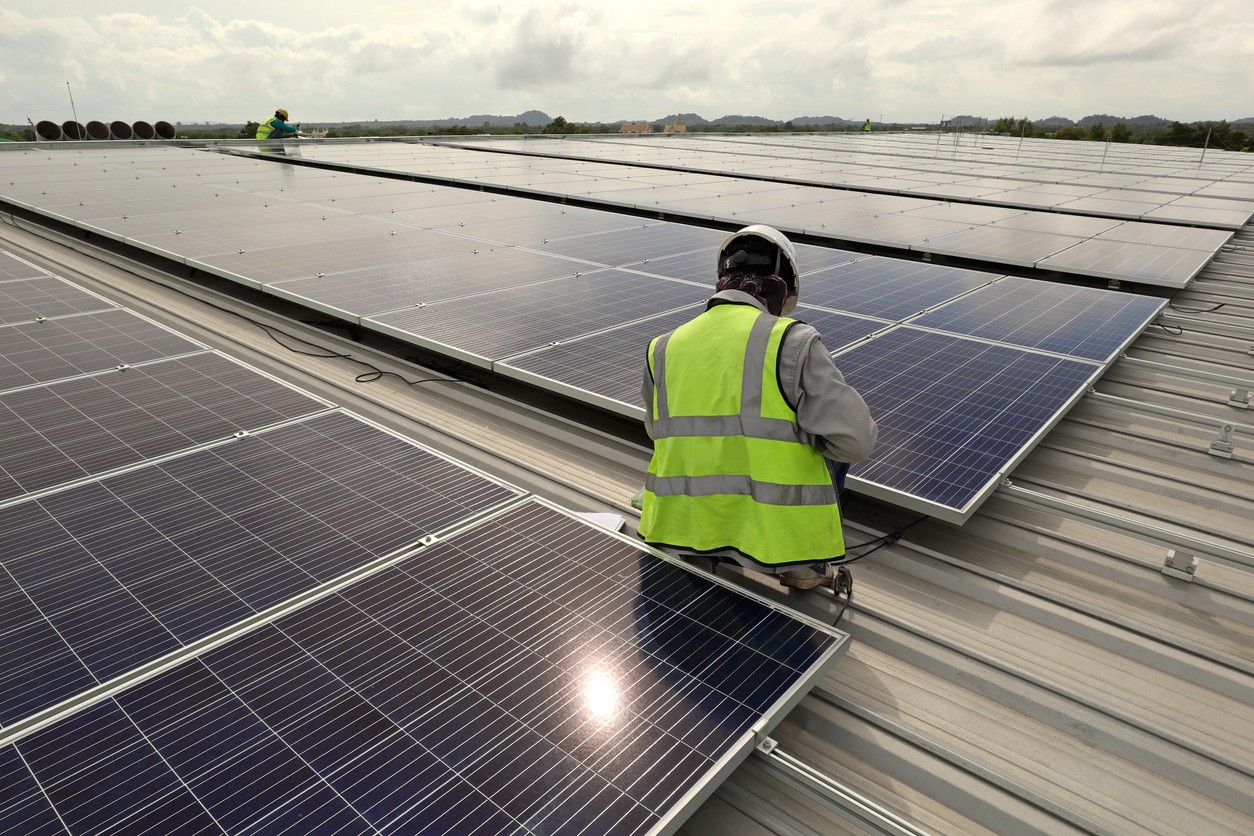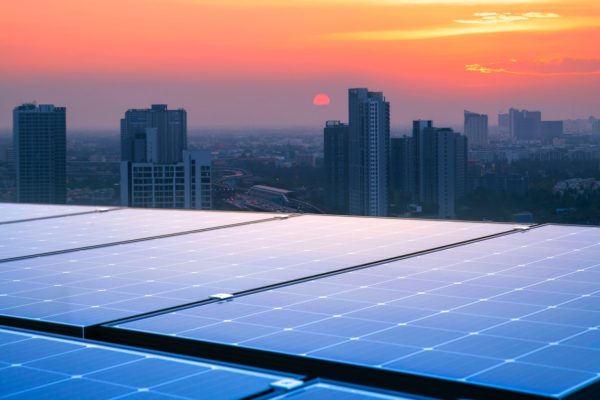
Solar energy is suitable for companies looking to reduce operating expenses and boost their bottom line. Apart from lowering the company’s carbon footprint, going solar also shows customers and stakeholders that the company is dedicated to sustainability and switching to renewable energy.
Are you a company owner or decision-maker who is thinking about using commercial solar power? Or are you merely interested in evaluating solar electricity for your company? You can learn anything you need to know from this blog about commercial solar panels’ costs.
What are Commercial Solar Systems?

Solar panel installations in the commercial and industrial sectors are referred to as commercial solar. It is a broad category that includes any solar power usage unrelated to residential, utility (solar farms), or solar panels for homes. However, commercial solar covers companies, nonprofits, and governmental bodies.
Some examples of companies and organizations that have installed commercial solar energy systems are:
- Vineyards, farms, and ranches
- Warehouses and factories
- Clinics and hospitals
- Schools and childcare facilities
- Parking lots, parking garages, etc
- Commercial office buildings
- Retail stores and shopping centers
You must be clear now that many businesses can benefit from solar energy.
Where Are Commercial Solar Installations Possible?

Commercial solar systems can be installed in various structures and settings, and organizations can use them. In contrast to utility-scale plants, primarily ground-mounted solar farms, and residential solar plants, which are overwhelmingly on the rooftops of homes, commercial solar panels are in high demand, and their service providers operate from different locations.
Commercial solar panels can be deployed in a variety of places, some of which are listed below:
- On a flat roof or other flat surfaces
- Sheds and barns
- The awnings and rooftops of commercial buildings
- Patio coverings, gazebos, and pergolas
- Parking shades and garages
- Mounting poles
- Ponds and man-made lakes, often known as “photovoltaics,”
Cost of Commercial Solar Systems

Over the past few decades, as technology has advanced to a much higher level of efficiency and the market has expanded, there has been a significant shift in the price of installing solar panels.
According to research by the International Renewable Energy Agency (IRENA), the cost of solar photovoltaic power decreased 82% globally between 2010 and 2019; similar trends may be seen in the prices associated with installing the panels.
It is no surprise that costs have decreased, considering the huge number of enterprises operating. As per the report of the National Solar Database of the Solar Energy Industries Association, there are more than 10,000 solar enterprises in the US alone.
Solar Energy Industries Association stated that commercial solar panel systems cost an average of $1.45 per watt as of Q4 2021, slightly less than the $3.06 cost of installing a system in a home.
There are a few things to determine while considering the cost of a properly installed solar power system in the US, such as the size of the solar system because you’ll need a different amount of energy for a small business and a large enterprise. However, a large-scale business will require more energy, which will be more expensive.
Another factor to consider while going solar for commercial use is the type of equipment because solar panels vary in size and operations. The different types include monocrystalline, polycrystalline, and panels made of thin films; all are beneficial depending on cost, efficiency, and aesthetics.
However, the solar system in the United States costs $2.60 to $3.20 per watt. If you pay this much, it should guarantee top-notch customer service for the entire 25-year lifespan of your solar panels.
In 2022, the average cost of installing home solar panels will be between $18,000 and $20,000. After applying for the federal solar tax credit, that cost would fall between $13,320 and $14,800.
You may spend between $50,000 and $100,000 for small to average-sized businesses, along with a 26% federal tax credit.
Incentives and Advantages of Commercial Solar Systems

There are various reasons for enterprises, governmental agencies, and nonprofit organizations to go solar. The following are the primary advantages and incentives for commercial solar panel systems:
- MACRS depreciation
- Flexible financing possibilities
- Tax credits for solar energy and other incentives
- Green credentials
- Quick payback period
- Electric bill offset
1. MACRS Depreciation
MACRS, also known as a modified accelerated cost recovery system, is a recovery period of five years for solar energy equipment because solar panels have a guaranteed lifespan of at least 25 years, so businesses will benefit from a sizable reduction in their tax obligations in the first five years of owning the system.
The solar tax credit could be combined with MACRS. Half of the solar tax credit’s value is deducted from the project’s cost base. Therefore, you’ll reduce the cost basis of the asset to 85% if you apply for the 30% tax credit.
2. Flexible Financing Possibilities
Commercial solar financing has flexible options; there are three ways businesses can pay for their solar panels.
Solar Lease: Also known as solar rent. In this condition, you have to pay a fixed monthly fee for using solar panels from a solar company.
Solar loan: You obtain a loan to pay for the solar panels and pay it back over a period of five to twenty years.
Power Purchase Agreement: You consent to pay the agreed-upon price per kilowatt-hour (kWh) for the electricity generated by the solar panels.
Solar leases and Power Purchase Agreements do not qualify for the tax credit, although solar systems purchased with a solar loan qualify for the tax credit. Property owners prefer solar loans because they typically provide the best return on investment.
3. Tax Credits for Solar Energy and Other Incentives
The Solar Tax Credit, called the Clean Energy Credit, subsidizes 30% of installing solar panel systems.
Therefore, if your company spends $50,000 to install a solar power system, it will get a $15,000 tax credit. Utilities, states, and local governments may offer additional incentives for businesses that adopt solar. You can check the available incentives in your area.
4. Green Credentials
Companies that pay attention to their customers’ interests often succeed and get increased brand loyalty. However, organizations that don’t care what their consumers want are doomed to failure. Some consumers have strong feelings about climate change and care about the well-being of our planet.
According to a study, 79% of American adults have changed their purchases for social responsibility, inclusiveness, and environmental impact. Companies must demonstrate their commitment to sustainable development and renewable energy to prove that they are aware of these issues and care about them.
Only caring and claiming about these issues isn’t enough; it would be better if companies shifted towards solar energy to represent green initiatives. Big corporations like Apple, Google, Amazon, Walmart, and Target have adopted these initiatives, installed enormous amounts of solar capacity, and made bold announcements about their ambitious goals to switch to clean energy.
Your solar project doesn’t have to be as large as these big organizations, and your consumers will count the baby steps you take until you switch entirely to green energy.
5. Quick Payback Period
The power bill savings, MACRS depreciation tax, and subsidies illustrate that commercial solar payments can provide a strong return on investment. If you realize how long the solar panels last, you’ll understand it is a reasonably short payback period.
Your solar panels should last at least 25 to 30 years, which is the average length of time, and the performance warranty cards have almost equal time for solar panels, which is a win-win situation.
6. Electric Bill Offset
A commercial solar power system can completely offset a company’s electricity costs. Installing a grid-tied system enables you to export excess power to the grid and import power to make up for shortfalls when necessary, making it simple to completely offset your energy expenditure. You will even get paid the total retail rate for the power you export if net metering is enabled.
Complete electric bill offset means you will be protected if the utility rate ever increases. Because you generate and use your own energy, you’ll be less impacted by any future price increases for electricity. Also, you’ll experience a positive cash flow because many businesses that switch to solar enjoy this benefit from the start. If you have bought the panels, loan repayments may be less expensive than bill reductions.
Another benefit of electric bill offset is you get free electricity. Once you pay for your solar panels, your company will get free energy.
Coldwell Solar Designs and Installs Commercial Solar Systems
You must have been considering how much commercial solar installations cost for a while; we hope we have cleared some of your confusion, and now you can get started with your commercial solar project. Going solar won’t only benefit your company, but it also contributes to reducing your carbon footprint and the production of clean energy. You’ll be surprised how your consumers will react to this initiative, resulting in increased brand loyalty which is a positive sign for your business.
If you want to step forward and go green, contact Coldwell Solar for descriptive information regarding the cost and installation of a commercial solar system.

